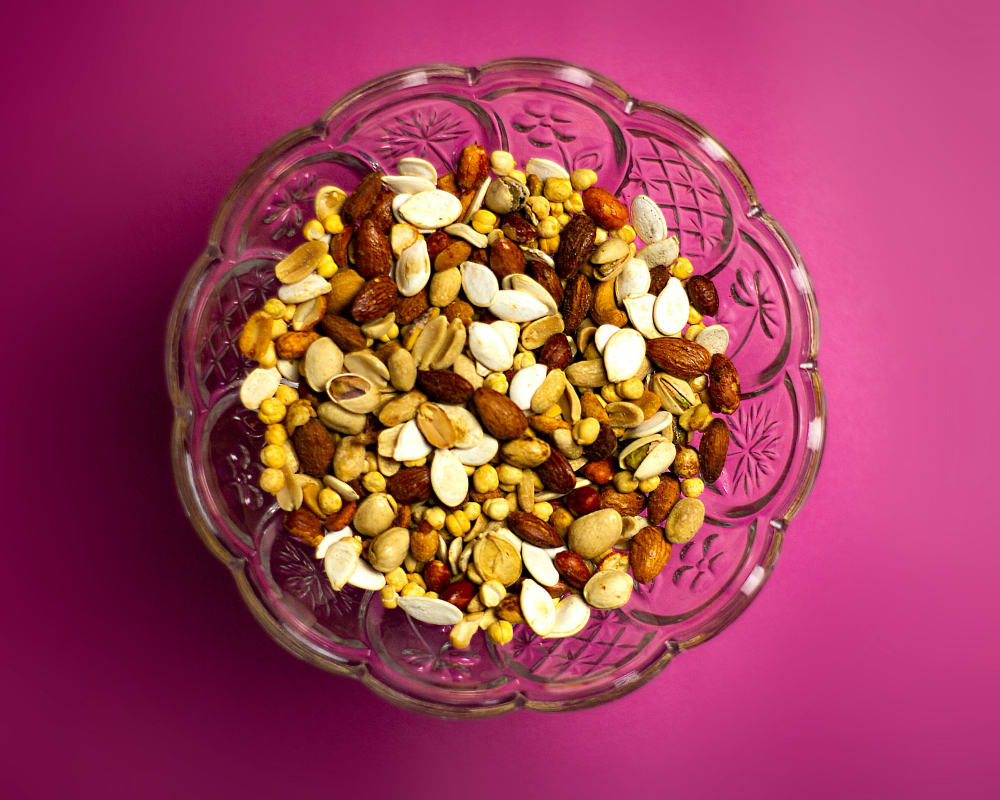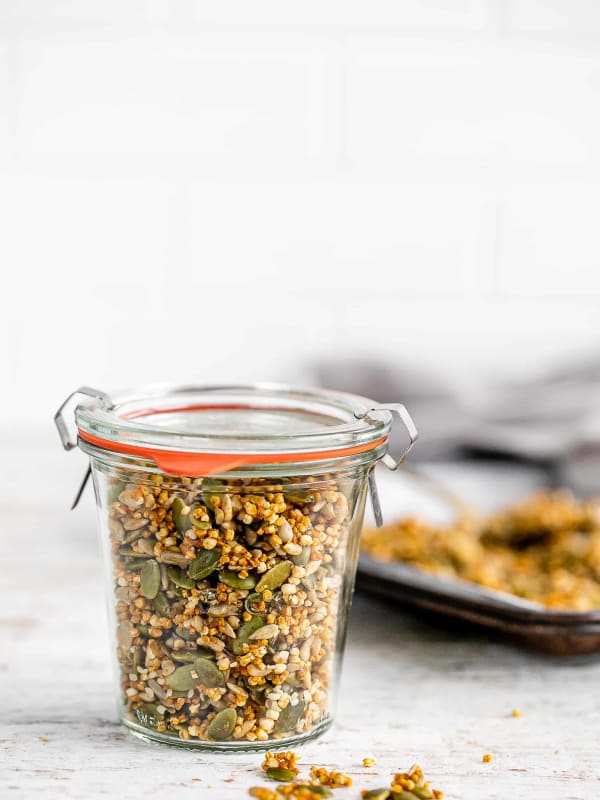High-Oxalate Foods: Risks, Symptoms, and Smarter Low-Oxalate Alternatives

High-Oxalate Foods: Risks, Symptoms, and Smarter Low-Oxalate Alternatives
Learn how oxalates affect kidney health, inflammation, and energy — plus safe alternatives.
If you've been dutifully sipping daily spinach smoothies and smearing copious amounts of almond butter on everything, thinking you're doing your body a favour with loads of plant-based superfoods, you're definitely not alone.
But what if some of these ostensibly healthy foods are quietly sabotaging your health instead? If you're struggling with joint pain, fatigue, skin issues, or mysterious inflammation, your diet might be playing a hidden role- and not because of other boogeymen like seed oils or added sugar.
Oxalic acids are naturally occurring defence compounds in many otherwise healthy plant superfoods. They can wreak havoc in high amounts by binding up minerals to form sharp oxalate crystals, which can then accumulate in body tissues. And if we're unaware of them, it can be pretty easy to eat a lot of them without even realizing.
To muddy the waters even more, oxalate food lists contradict each other massively - are blueberries high in them, or not?
This article will give you a practical guide to high-oxalate foods, smarter alternatives, and the science behind why it all matters. You'll also learn why gut health is a major unsung X factor, and that it's not just all about how many oxalates you do or don't eat.
In this article, you’ll learn:
- What oxalates do in the body
- Their link to gut and kidney health
- Smart tips to lower oxalates
- High-oxalate foods to avoid
- Easy low-oxalate food alternatives
What Oxalates Are, and Why They Matter
Since plants can't get up and run from hungry predators, all their defences are chemical. Oxalic acids fall into this category- they are naturally produced to protect the plant from various pests, large and small. Unfortunately, they're not so kind to humans, either. No one disputes their toxicity, and in high enough amounts, they can even be fatal.
In normal amounts, healthy kidneys can effectively filter them into the pee. Still, when that level is exceeded, oxalates can bind to minerals like iron, calcium, zinc, sodium, and potassium. Accumulating as sharp crystals in tissues over a long period of time, oxalate complexes can contribute to a wide range of health conditions:
- Kidney stones
- Brain fog
- Chronic fatigue
- Fibromyalgia-like pain or muscle aches
- Stiffness and joint pain
- Urinary urgency and interstitial cystitis
- Tingling or burning in the feet
- Skin issues (eczema, rashes)
- Digestive troubles
In some cases, people with these symptoms and others have gone through years of misdiagnosis before discovering that oxalates were the common thread. The sneaky part is that oxalates don't cause the same issues in everyone. Since oxalates can gather in any tissue of the body, they seem to show up wherever the body is most vulnerable.
It's commonly accepted that oxalate overload is the leading cause of kidney stones, 80 per cent of which are made of calcium-oxalate complexes. This painful condition will affect 1 in 10 people at some point in their lives. What is less understood, and more controversial, is the idea that oxalate accumulation can potentially do serious damage in virtually every other organ system as well.
What Oxalates Do in the Body
Once ingested, oxalates can bind to minerals (especially calcium) to form shard-like crystals that are hard for the body to eliminate. Kidney stones are just the beginning—they can also lodge in the eyes, joints, brain, skin, muscles, and genitals, accumulating over time and contributing to a nearly endless list of symptoms.
Oxalate overload is a slippery problem that can seem like an internal shape-shifter: it can mimic other conditions, change location, and flare up, all seemingly at random. The more you eat- especially from high-oxalate greens powders, nuts and nut-based snacks, or the plant-based 'superfoods' list above- the more your body has to manage this mounting crystal congestion quietly.


Gut Health: Oxalates and the Microbiome
Here's the big twist: not everyone absorbs the same amount of oxalates from the food they eat. The presence (or absence) of certain gut bacteria can make all the difference. One species, Oxalobacter formigenes, specializes in degrading oxalates- it literally lives off of them. Other species in the Bifido and Lactobacillus families also make major contributions to lightening the load.
But thanks to antibiotics, poor diet, or gut dysbiosis, many people lack these critical crystal-munching microbes. If you think about it, this explains a lot- for example, why some people seem to eat a lot of oxalate-rich foods without any trouble, or why oxalates are generally more important now than they would have been prior to heavy, widespread antibiotic use.
Focusing on the gut instead of resigning oneself to a lifelong low-oxalate reality makes a lot of sense. Let's not forget that high oxalate foods like spinach and beets are some of the healthiest in the world! Many have convincingly argued that unless we are highly prone to kidney stones, we should not make the mistake of throwing the superfood baby out with the oxalate bathwater. On the other hand, it also stands to reason that even a healthy gut might eventually be overwhelmed if the incoming oxalate quantity is just too much to handle.
Gut-Friendly Oxalate Management Tips
If you're struggling with symptoms and suspect oxalates to be the cause, smart kitchen strategies combined with rebuilding your gut ecosystem might be just as important as moderating your spinach intake.
Here are some holistic tips to manage oxalate intake the gutsy way:
- Consume fermented foods like sauerkraut, kimchi, kefir, or yogurt.
- Feed beneficial flora with a mix of prebiotic fibres.
- Avoid unnecessary antibiotic use.
- Maintain adequate calcium intake, as calcium will bind to oxalates in the gut to prevent them from being absorbed into circulation.
- Drink plenty of water, as this will also help to flush excess oxalates.
- Lemon water is particularly helpful, as the citric acid will help break down oxalate complexes that have accumulated in the body.
- Steam, boil, or pre-soak your higher-oxalate veggies. Studies have shown that all three can majorly reduce oxalate content of the resulting meal. Unsurprisingly, fermentation helps reduce oxalate content of food as well.
- Increase magnesium intake from food or supplements. Not only will it fight constipation and assist relaxation, but it will help to prevent accumulation of oxalate mineral complexes in tissues.


High-Oxalate Foods to Watch Out For
The following foods are categorically unsuitable for a low-oxalate diet.
Veggies:
- Spinach
- Rhubarb
- Swiss chard
- Beets (and especially beet greens)
- Sweet potatoes
- White potatoes (especially with skin)
- Okra
- Artichoke hearts
- Carrots
- Celery
- Sorrel
- Cactus
Nuts and Seeds:
- Almonds
- Cashews
- Pine nuts
- Chia seeds
- Hemp seeds
- Poppy seeds
- Sesame seeds
- Peanuts
Legumes and Grains:
- Soybeans (edamame, tofu, etc.)
- Miso
- Black beans
- White beans
- Bran
- Whole wheat
- Brown rice
- Tapioca
- Arrowroot
- Quinoa
- Amaranth
- Buckwheat
- Teff
Fruits:
- Figs
- Apricots
- Blackberries
- Goji berries
- Mulberries
- Kiwi
- Clementines
- Tangerines
- Pomegranate
- Starfruit
- Plantain
Spices and Additives:
- Turmeric powder
- Caraway seeds
- Cocoa powder
- Dark chocolate
- Carob
- Parsley
- Black pepper
Beverages:
- Almond milk
- Soy milk
- Black and green tea
Low-Oxalate Alternatives
A low oxalate diet aims to keep oxalate intake under 100mg per day, or lower. If you're trying to cut back, here's what you can eat instead to make that pretty much automatic:.
Vegetables:
- Cabbage
- Arugula
- Lettuce
- Yellow squash
- Cauliflower
- Red radish
- Red pepper
- Kohlrabi
- Asparagus
- Onions
- Turnips
- Pumpkin
- Cilantro
- Watercress
- Mustard greens
- Lacinato kale
- Rutabaga
- Celeriac
Fruits:
- Blueberries
- Melons
- Pineapple
- Apples
- Oranges
- Dates
- Grapes
- Mango
- Papaya
Animal Foods:
- Meat (beef, chicken, turkey, lamb, pork)
- Eggs
- Liver and organs
- Fish and shellfish
- Bone broth
Fats and Dairy:
- Coconut oil
- All dairy (milk, cheese, cream, butter, ghee)
- Olive oil
- Macadamia oil
Legumes and Grains:
- White rice
- White flour
- Pearl barley
- Mung beans
- Yellow or green split peas
- Black-eyed peas
Nuts and Seeds (in moderation):
- Macadamia nuts
- Pumpkin seeds
- Sunflower seeds
- Flax seeds
- Walnuts
Beverages:
- Coconut milk
- Herbal teas (mint, lemon balm, rooibos, chamomile)
Spices and Additives:
- White chocolate
- Chocolate extract
- White pepper
- Sage
- Thyme
- Mustard
- Horseradish
- Marjoram
- Chives
- Dill
- Rosemary
Frequently Asked Questions
Q: Should everyone reduce oxalate intake? Not necessarily. Some people tolerate moderate levels without issue, especially if they have the right gut bacteria in abundance. But for sensitive individuals or anyone dealing with chronic symptoms, it might be worth exploring. In any event, it certainly doesn't hurt to be aware of high oxalate foods and alternatives.
Q: How quickly should I reduce oxalates? Slowly. Rapid removal of all oxalates can lead to a phenomenon known as "oxalate dumping." In this phase, stored crystals begin mobilizing, potentially causing an increase in symptoms before things start to get better. Taper down slowly and steadily over a period of weeks.
Q: But what if I love spinach smoothies and almond milk? You're not alone- but there are easy alternatives. Coconut milk in place of almond, and arugula instead of spinach, make swaps pretty easy.
Q: Are animal foods all low-oxalate? Yes! Meat, fish, eggs, and dairy are all virtually oxalate-free. Our bodies even produce some oxalates- but in terms of dietary intake, it's really an issue that only pertains to (some) plant foods.
Q: What's the best first step? The best way to start is by swapping out the biggest culprits: spinach, almonds (and almond milk), beets, and sweet potatoes. If any of these are daily go-tos, they deserve extra scrutiny. Track your symptoms, take it slow, and gradually expand your changes from there.
If this article helped clarify things, you might also want to check out: Nightshades, What Are They, and Are They Bad For You?
Ali, L. M. (n.d.). High-oxalate foods: Are they bad for kidneys? - goodrx. GoodRX. https://www.goodrx.com/well-being/diet-nutrition/high-oxalate-foods-bad-for-kidney-stone
Attalla, K., De, S., & Monga, M. (2014). Oxalate content of Food: A Tangled Web. Urology, 84(3), 555–560. https://doi.org/10.1016/j.urology.2014.03.053
Bowstadmin. (2025, July 15). Why high oxalates can harm your health. MosaicDX. https://mosaicdx.com/resource/high-oxalate-a-major-factor-in-tissue-and-blood-vessel-health/
Chai, W., & Liebman, M. (2005). Effect of different cooking methods on vegetable oxalate content. Journal of Agricultural and Food Chemistry, 53(8), 3027–3030. https://doi.org/10.1021/jf048128d
Daniel, S. L., Moradi, L., Paiste, H., Wood, K. D., Assimos, D. G., Holmes, R. P., Nazzal, L., Hatch, M., & Knight, J. (2021). Forty years of Oxalobacter formigenes, a gutsy oxalate-degrading specialist. Applied and Environmental Microbiology, 87(18). https://doi.org/10.1128/aem.00544-21
FARRE, M. (1989). Fatal oxalic acid poisoning from Sorrel Soup. The Lancet, 334(8678–8679), 1524. https://doi.org/10.1016/s0140-6736(89)92967-x
Finkielstein, V. A. (2006). Strategies for preventing calcium oxalate stones. Canadian Medical Association Journal, 174(10), 1407–1409. https://doi.org/10.1503/cmaj.051517
Friedrich, C. (2020, July 5). Truth or myth: Oxalates are bad for you. Cathe Friedrich. https://cathe.com/truth-or-myth-oxalates-are-bad-for-you/
Harris, J., & Coe, F. on J. (n.d.). How to eat a low oxalate diet. Kidney Stone Program. https://kidneystones.uchicago.edu/2015/11/16/how-to-eat-a-low-oxalate-diet/
Jarry, J. (2023, March 31). The demonization of dietary oxalate has begun. Office for Science and Society. https://www.mcgill.ca/oss/article/critical-thinking-health-and-nutrition/demonization-dietary-oxalate-has-begun
Karamad, D., Khosravi-Darani, K., Khaneghah, A. M., & Miller, A. W. (2022). Probiotic oxalate-degrading bacteria: New insight of environmental variables and expression of the OXC and FRC genes on oxalate degradation activity. Foods, 11(18), 2876. https://doi.org/10.3390/foods11182876
Link, R. (2024, January 2). Should you be following a low oxalate diet?. Dr. Axe. https://draxe.com/nutrition/oxalate/
Little known facts about oxalates and their poisonous effects. Sally K. Norton. (2025a, March 8). https://sallyknorton.com/oxalate-science/
Miller, A. (2025, April 22). Antibiotics, high-fat, high-sugar diets and microbial oxalate metabolism. Cleveland Clinic. https://consultqd.clevelandclinic.org/antibiotics-high-fat-high-sugar-diets-and-microbial-oxalate-metabolism
Miller, A. W., Oakeson, K. F., Dale, C., & Dearing, M. D. (2016). Effect of dietary oxalate on the gut microbiota of the mammalian Herbivore Neotoma Albigula. Applied and Environmental Microbiology, 82(9), 2669–2675. https://doi.org/10.1128/aem.00216-16
Miller, A., & Dearing, D. (2013). The metabolic and ecological interactions of oxalate-degrading bacteria in the Mammalian Gut. Pathogens, 2(4), 636–652. https://doi.org/10.3390/pathogens2040636
Mitchell, T., Kumar, P., Reddy, T., Wood, K. D., Knight, J., Assimos, D. G., & Holmes, R. P. (2019). Dietary oxalate and Kidney Stone Formation. American Journal of Physiology-Renal Physiology, 316(3). https://doi.org/10.1152/ajprenal.00373.2018
Newman, T. (2024, December 30). Should you worry about oxalates?. Should You Worry About Oxalates? https://zoe.com/learn/oxalates-nutrition-safety
Noonan, & Savage. (n.d.). Oxalate content of foods and its effect on humans. Asia Pacific journal of clinical nutrition. https://pubmed.ncbi.nlm.nih.gov/24393738/
Oxalate content of 750+ foods. Oxalate Content of 750+ Foods. (n.d.). https://oxalate.org/
Oxalate Food List - kidney stone diet with Jill Harris. Kidney Stone Diet. (2024, October 14). https://kidneystonediet.com/oxalate-list/#list
Penninston, K. (n.d.). Is it time to retire the low-oxalate diet? yes | journal of endourology. https://www.liebertpub.com/doi/abs/10.1089/end.2021.0581?journalCode=end
Penniston, K. L. (2021). Is it time to retire the low-oxalate diet? yes. Journal of Endourology, 35(10), 1431–1434. https://doi.org/10.1089/end.2021.0581
Privelli, J. (n.d.). Is it time to retire the low-oxalate diet? yes | journal of endourology. https://www.liebertpub.com/doi/abs/10.1089/end.2021.0581?journalCode=end
Sally K. Norton, M. (2023). Toxic superfoods Sally K. Norton, mph. Rodale Books.
The sneaky allure of a detox - the new york times. New York Times. (n.d.). https://www.nytimes.com/2023/01/30/well/eat/detox-cleanses.html
Urology & Nephrology. Cleveland Clinic. (n.d.). https://consultqd.clevelandclinic.org/urology-nephrology
Wadamori, Y., Vanhanen, L., & Savage, G. (2014). Effect of kimchi fermentation on oxalate levels in silver beet (beta vulgaris var. CICLA). Foods, 3(2), 269–278. https://doi.org/10.3390/foods3020269
What are kidney stones?. Cleveland Clinic. (2025, June 2). https://my.clevelandclinic.org/health/diseases/15604-kidney-stones
What is oxalate and how can it impact your health?. Sally K. Norton. (2025b, March 8). https://sallyknorton.com/oxalate-science/oxalate-basics/
Lead photo by Usman Yousaf on Unsplash.
